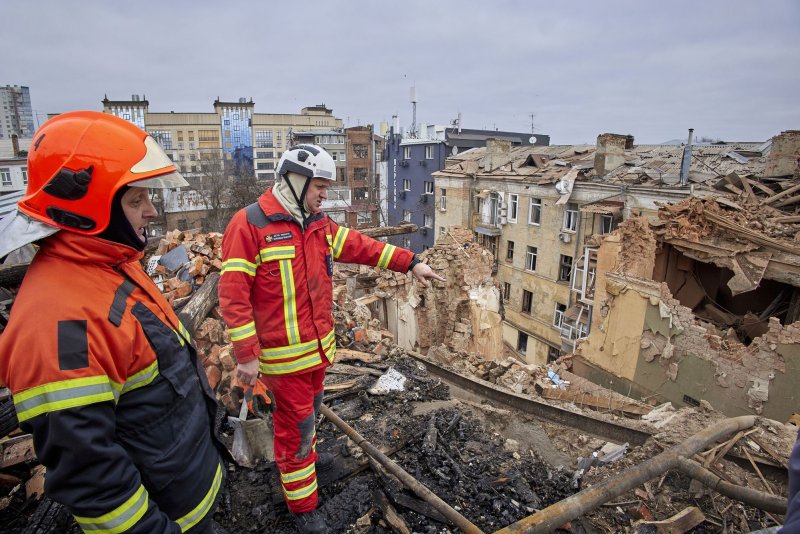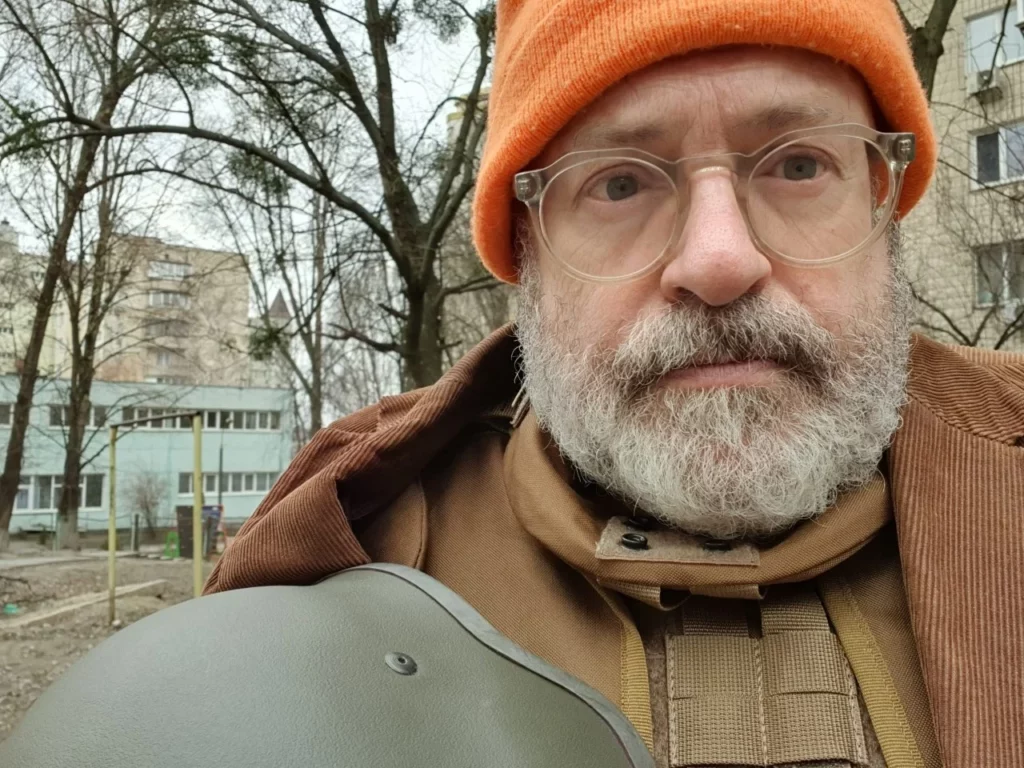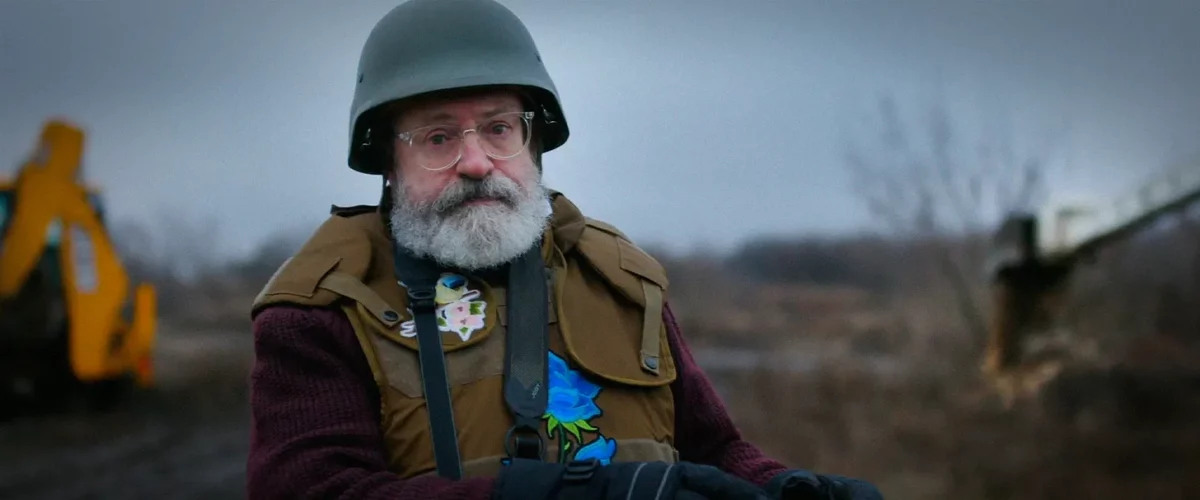Veteran correspondent John Sweeney went to Ukraine to record what was happening on the ground, and found brutal Russian aggression and evidence of war crimes, writes Eliot Wilson
If you have ever wondered what it must be like to have the full, technicolour horror of a violent warm film brought to the street on which you live, ask a Ukrainian. This what Vladimir Putin has done to Ukraine since 2022. On 24 February last year, at around 3.40 am Kyiv time, Russian armour and infantry with substantial support from artillery and air power poured over the border in four main spearheads. Ukraine’s armed forces, though taken by surprise, reacted fiercely and fought like lions.
John Sweeney is a veteran of reporting from challenging situations, as anyone who remembers his spectacular loss of temper with a particularly odious spokesman for the Church of Scientology in 2007 will attest. He has long been a keen observer and harsh critic of President Putin: he reported on the war in Chechnya in 2000, covered the initial Russian occupation of Crimea in 2014 and backing for separatist forces in Donbas and last year he published Killer in the Kremlin: The explosive account of Putin’s reign of terror. Sweeney is not a fan of the Russian leader, and recently popularised the Twitter hashtag #DoFuckOff.
When the Russian invasion began, Sweeney travelled to Ukraine to document the war. With financial backing from Byline TV, he and director Caolan Robertson have made a film of their experiences in the war zone, partly to show a wider audience what things are like on the ground, and partly to collect evidence that Russian forces in Ukraine have been guilty of war crimes and crimes against humanity. On both counts, The Eastern Front succeeds brilliantly.
We begin in Dnipro, a city of a million souls in eastern Ukraine. In a shattered block of flats, a bright yellow kitchen—or at least what’s left of it—then, horribly, we see smartphone footage of the same kitchen from a few days before: a child is celebrating her birthday with a cake and candles. Her father was killed in the missile strike which brought down half the building. The juxtaposition is terrible to behold, but it introduces what will become a hallmark of this film, the volume of footage shot by ordinary people on their phones. Everyone is now a camera operator.

The film follows Sweeney, Robertson, war photographer Paul Conroy and American author and journalist Zarina Zabrisky who writes for Byline Times, to some of the most dangerous parts of the conflict zone: Bakhmut, far in the east of the country, Kherson at the mouth of the Dnieper river and close to the front line at Chasiv Yar, where Ukraine artillery is firing shells into the sky, guided by camera-carrying drones. All four maintain admirable calm, but the atmosphere is tense, the sound of gunfire ever-present. Sweeney tells Robertson that you can tell the difference between incoming and outgoing artillery, and what they are hearing is outgoing. Still, there is the occasional flinch.
What Sweeney finds is horrifying. The devastation wrought by the Russian invasion is bad enough. It is part of the Kremlin’s method of warfare to target civilians in large numbers and try to instil terror in the population (itself in breach of the Geneva Conventions), and the audience sees, and feels viscerally, the devastating effect with modern artillery has on densely populated urban areas, the carefully constructed lives of peaceful men and women torn and smashed to pieces by the endless rhythm of incoming ordnance. (To give you a notion, it is estimated that Russian forces in Ukraine are firing 20,000 shells every day.) This is enough to shock you. But it is merely the beginning.

Sweeney has a case to prove against Vladimir Putin, and the evidence is there. In Kherson, a resident shows them footage of a shower of thermite bombs, incendiary weapons which burn at 2,400°C and cannot be extinguished with water. The use of these munitions against civilian targets is against international law. In the same city, they see subterranean Stalin-era detention cells, closed when Ukraine became independent but pressed swiftly back into use when the Russians seized control of the city early in the conflict. Sweeney speaks to a man who was detained and tortured in the cells: his initial calm and the eventual, and apologetic, crack in his façade is heartbreaking. Another victim explains evenly that Russian policemen used a wind-up field telephone to power electrodes which they attached to his ears, his fingers and his toes. Some Ukrainians subjected to torture were not so “lucky”. Bodies were seen being carried away.
This film is a polemic. And it is all the better for it. By travelling around Ukraine, speaking to ordinary people, hearing stories of terrible suffering and horror, and experiencing without overstating their own degree of physical jeopardy, Sweeney and his team show the facts to the world. The effect is devastating. Anyone who thinks they have become blasé or bored by tales from the conflict in Ukraine need to see this film.
The real stars of the film are the Ukrainian people. They speak to Sweeney usually in calm or resigned tones, usually keeping their trauma concealed, though occasionally they will cough up an irrepressible sob or shudder uncontrollably. But their real suffering is shown in tiny signs and cues: one man in Dnipro explains that everyone has a contact in their phone that they can’t call any more. After a beat you realise he means they’ve been killed. Another, describing the brutal experience of being shelled, says sourly “If Hell exists, it came here to Kherson”.
But anger is muted, despair in check, a slightly cynical acceptance half-grinned from the side of the mouth. Sweeney asks a Ukrainian if he hates the men who have done this to his country. The man sighs. “They have families, they have parents. How would they feel if this was happening to them?” There is true humanity, exhausted, downbeat, but not extinguished.
The Eastern Front, shot by Robertson and brilliantly edited by George Llewelyn, is a beautiful film. It captures the feel of a cold, bright winter’s day: sunlight flares in rainbow circles and dazzles the eyes, and the colours of sky and land seem faded and detached. Robertson has a superb eye for the detritus of war: a child’s shoe, a shattered window, a burned-out car. Suddenly you are not in comfort 1,500 miles away, but there in the chill air of eastern Ukraine, the drumbeat of artillery in the background, the mud glutinous and sucking underfoot. When Sweeney descends into the Kherson torture chambers, the stale, foetid air is choking and heavy with misery and dank with fear.
This is not a dispassionate documentary, nor was it ever intended to be. It is an exquisitely crafted, moving, strangely romantic indictment of Russian brutality. It deserved to be seen by a huge audience. And each one of them will, and must, emerge ready to hiss “J’accuse!” at the butcher in the Kremlin.
Read director Caolan Robertson’s account of making the film here.
The Eastern Front is available on Byline TV and will be on Amazon Prime soon.

